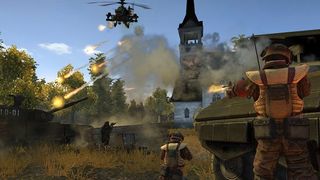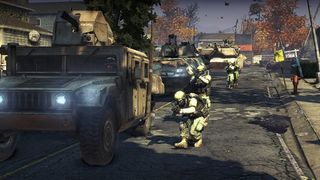Homefront hands-on preview
Never have we been killed so much by toy helicopters
The other item that makes Homefront stand out even more, for better and for worse, is the availability of drones. We’re not talking predator drones here, but rather small, remotely-piloted attack and surveillance craft. We’ve seen a tiny attack chopper, a miniature tank with an LMG mounted on it, and a flying spy craft. The attack chopper was the most popular by far in the matches we played, and frankly felt extremely overpowered. We’re talking about a flying rocket platform that can typically take out a player with two shots that also have considerable splash effect. In every match we played, there were at least two (and usually more) of these rocket-spamming mini-choppers in the sky at any given moment. Flying these things is fun, and we racked up some disquietingly easy kill-streaks with them – they seem to have no timer that we could discern, so one can fly around for minutes at a time.

Above: This is not the mini-chopper. This real chopper is a high-level vehicle
The second most popular drone was the Parrot, a spy craft that has no weapons but instead tags enemies so they show up on radar and are also visible through terrain with a big red diamond around them. These drones are a nice touch because they give lesser-skilled or team-oriented players a chance to make a difference, and it’s possible to earn considerable BP without getting a single kill. The last drone, which we saw little of but enjoyed piloting ourselves, was the Wolverine. It looks like a small tank but certainly doesn’t have the armor to stand up to much damage, but unlike the drone chopper, can easily sneak inside buildings and kill those hiding from said choppers.
While these drones make Homefront’s multiplayer feel somewhat different from other shooters, they also raise concerns for us around what they turn gameplay into. First, they are so cheap to purchase that every player can launch one immediately at the beginning of a match. This means that rocket-raining choppers show up in the first few seconds of play almost every round. The result is a certain number of players just hunkered down in some corner of the map instead of fighting the enemy face-to-face. The other problem is that, especially with the mini-choppers, these things are incredibly difficult to hit. We’re talking about a flying object less than half the size of a normal player, which also strafes and skips around, making them even more difficult to hit. Shooting at small, armored helicopters and knowing that even if you do destroy it you don’t even earn a kill is not fun. We spent a lot of time hiding inside of buildings just trying to ignore them.

However, we must stress that this was an event involving brand-new players using low-level characters, so the dynamic could change drastically as people figure out the multiplayer. We saw a bit of this toward the end of our play time because people had leveled up and unlocked vehicles, and vehicles can treat drones as a minor annoyance. There are also potential weapon combinations that work best for dealing with drones, so it’s possible the overabundance of robots won’t be an issue soon after release. Even so, the chaos element that drones introduce does make the game feel fresh on one level.
A final component of Homefront’s multiplayer that makes it noteworthy is the way it creates a shifting battlefield. Its take on control-point play, where there are three areas teams fight to take over and hold, does a fun little twist where if one team manages to dominate, the “front line” of battle shifts, moving the three control points to another part of the map, simulating the need for the losing team to “fall back.” This can create a neat tug-of-war as the front line moves back and forth and ensures that you’re not fighting over the same parts of the map the whole round.

The other way Homefront moves the focus of fights happens with a kind of notoriety system. If you manage to rack up a kill streak or simply excel in a particular way, you’ll gain a kind of threat rating which then causes a commander AI to assign kill missions against you. Aside from simply enjoying the notoriety of being the most wanted player on the field, you’ll also earn bonuses for going up the ranks. The ultimate threat rating is five stars, and from our experience it is not easy to reach – not only did we achieve only three stars, but we didn’t see anyone else reach five stars during our play time. This feature adds another layer, a kind of minigame that lets players get fifteen minutes of fame for both being wanted and for killing the wanted player.
Sign up to the GamesRadar+ Newsletter
Weekly digests, tales from the communities you love, and more
Homefront has taken bold steps with its story, crafting a world that feels unnerving and real where most shooters go straight to the sensationalism and improbable set-pieces. It’s strange, then, that the multiplayer brings its “gamey” elements to the forefront. It has tried to make its multiplayer really stand out with its Battle Points and drones, but these mechanics don’t really make it all that different from Call of Duty or Battlefield. Clearly the devs have put considerable effort into the multiplayer – this is no tacked on obligation. It doesn’t look like, though, that the multiplayer will be the main reason to buy the game – instead, we’re betting players will be interested in the campaign and then enjoy the multiplayer as a hefty bonus. We just hope those mini-choppers find a natural place in the hierarchy, either through designed obsolescence, or if necessary, a balance patch.
Jan 21, 2011

Oh, that's why the Stellar Blade devs were terrified by demo players: one fan's spent "about 60 hours" maxing Eve's skill tree before the action RPG is even out

A new Taylor Swift song mentions GTA, but some remember it mentioning Baldur's Gate 3, Final Fantasy 14, and more in hilarious Twitter trend
Most Popular





